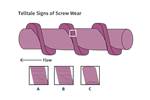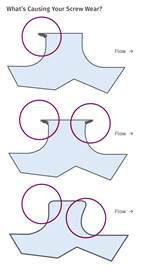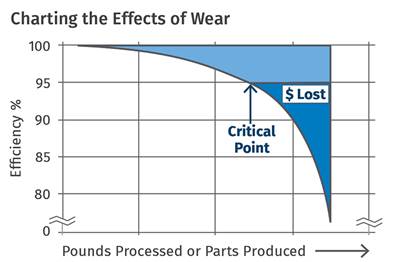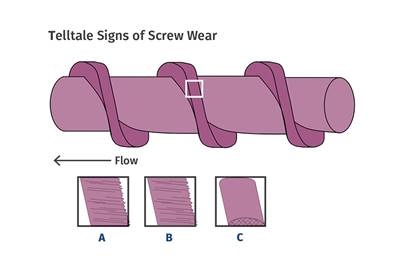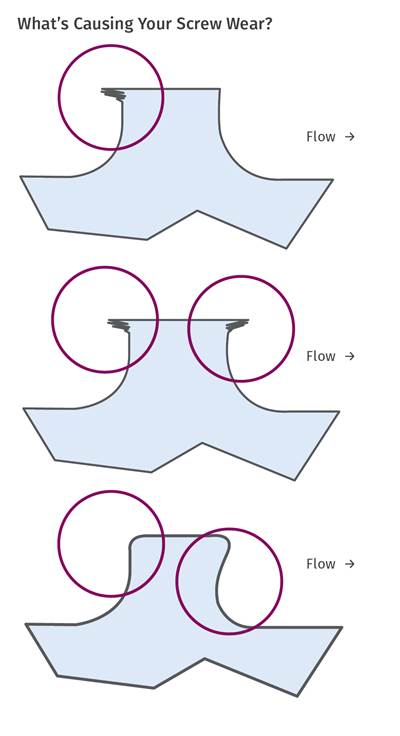Troubleshooting Screw and Barrel Wear in Extrusion
Extruder screws and barrels will wear over time. If you are seeing a reduction in specific rate and higher discharge temperatures, wear is the likely culprit.
Keeping single-screw extruders running at peak performance is a constant challenge for processors, especially for older machines. Typically, as an extruder runs in production, the screw and barrel will show signs of wear. The main signs include a reduction in specific rate and higher discharge temperatures. Specific rate is simply the rate (lb/hr or kg/hr) divided by the screw speed.
For small reductions in specific rate, the processor can just increase the screw speed to maintain output rate. Due to the higher screw speeds and material leakage over the flight clearance, wear can cause the discharge temperature to increase. Eventually, the wear level will be high enough that the processor will need to decrease the throughput rate of the line to maintain product quality. This will decrease the profitability and capacity of the line. The decision to replace a worn barrel and screw must include the economics of the process.

Images. M. Spalding, T. Womer
It is important to understand the diameters of the screw and barrel when new. These diameters for plasticating extruders are provided in the accompanying table. As a guideline, the flight clearance is typically the nominal screw diameter divided by 1000. For example, for a 3.5-in. diam. extruder, the flight clearance when new is about 0.004 in. per side for an outside screw diameter of 3.492 in. with a tolerance of 0.001 in. oversize. The barrel inside diameter is typically the nominal diameter with a tolerance of 0.001 in. oversize. Clearance distance beyond this is due to wear. Extruders larger than 12 in. typically have larger clearances than the rule provided, especially for melt-fed extruders.
The effect of screw wear on extruder performance can be costly. For example, the screw speed and discharge temperature as a function of screw wear (increase in flight clearance) at constant rate are shown in Fig. 1 for a 100- mm diam. screw running a 1 melt index (MI) PE at 150 kg/hr. When the screw was new, the flight clearance was 0.005 in. per side and the extruder was operating at its optimal performance with a discharge temperature of 236oC.
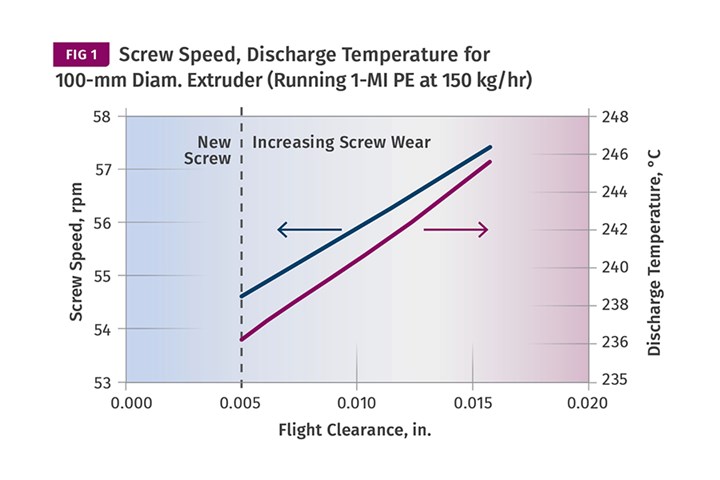
The effect of screw wear on extruder performance can be costly. As the screw wears, the flight clearance increases with the partial removal of the hard facing on the flight tips. To operate at a constant rate of 150 kg/hr, the screw speed must be increased. With the higher screw speeds and lower heat-transfer coefficients at the barrel wall, the discharge temperature increases. The heat-transfer coefficient decreases because the film thickness on the barrel wall increases as the flight clearance increases with wear.
As the screw wears with service time, the flight clearance increases with the partial removal of the hard facing on the flight tips. For the extruder to operate at a constant rate of 150 kg/hr, the screw speed must be increased. With the higher screw speed and lower heat-transfer coefficient at the barrel wall, the discharge temperature increases. The heat-transfer coefficient decreases because the film thickness on the barrel wall increases as the flight clearance increases with wear.
The effect of screw wear on extruder performance can be costly.
If the downstream process (such as a blown film) can run at the higher discharge temperatures, the operator will simply increase the screw speed to maintain rate. If the discharge temperature becomes too high for the operation, then the operator will need to decrease the screw speed and rate until the downstream process is stable. At a reduced production rate, however, the line becomes less profitable.
For a blown film application and a screw with 0.011 in. of wear (0.016 in. flight clearance), operation at 150 kg/hr will likely not be possible since the discharge temperature would approach 246oC, a temperature too high for this application. Instead, the rate would be decreased by up to 20 kg/hr and screw speed reduced by 7 rpm to maintain the discharge temperature at 236oC. This would decrease the rate by about 13%, reducing the profitability and capacity of the line. If the line is sold out, some orders could be late.
There have been many articles and discussions, especially in this magazine, of when a worn screw should be replaced with a new or refurbished screw. Some of the practices include: 1) when the wear level causes the flight clearance to be 4 times (4×) the clearance when new; 2) when the hard facing is totally worn off; and 3) when the rate reduction and discharge temperature increase to an uneconomical level. The hard facing on the flights is typically about 0.060-in. thick, while the clearance per side for new screws is typically the diameter divided by 1000.
For small-diameter screws, if the hard facing is completely worn off, the performance of the screw will be extremely poor. However, some applications can tolerate a 4× increase in flight clearance. But the best decision would be to change the screw when the economics of the process warrant the cost of a new or refurbished screw. The level of wear typically depends on the required performance or duty of the process, as shown by Fig. 2.
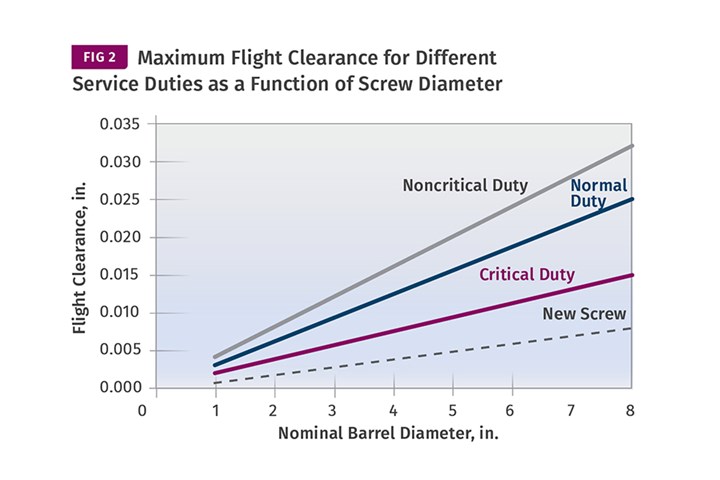
the process warrant the cost of a new or refurbished screw. Noncritical applications such as corrugated pipe can produce acceptable product using a screw that has a very high level of wear. On the other hand, a critical-duty process such as medical would not be as tolerant of a high level of wear.
For example, noncritical applications such as corrugated pipe can produce acceptable product using a screw with a very high level of wear. A critical-duty process such as medical applications would not be as tolerant of high wear. Instead, the screw would need to be replaced after the flight clearance increased to 2× the flight clearance when new.
A spare screw should be kept in storage so that when the current screw is worn to the end of its service life, the spare can be installed without shutting down the line for extended periods of time. The worn screw should be either refurbished or replaced. A screw should never be refurbished more than three times, because each time the new hard facing is welded onto the base material, the base material deteriorates and delamination between the hard facing and the base metal most likely will occur.
When the screw is out of the extruder, the inside diameter of the barrel should be measured for wear. A barrel that has an iron-based bimetallic liner will typically last for three times the service life of a screw. Also, the normal thickness of the barrel’s finished bimetallic liner is approximately 0.060 in.
Wear on the screw and barrel can be caused by several mechanisms, such as abrasive wear from fillers in the resin, from solids wedging at the end of the melting section or in front of a mixer, or poor barrel alignment. The mechanisms for these types of wear were well described by Jim Frankland in the November 2020 issue of this magazine. Abrasive components in the resin can cause high wear rates, especially where the channels have high levels of solids. Common abrasive fillers include glass fibers, silica and calcium carbonate, to name a few. If high levels of solids occur at the end of the melting section or at the entry to some mixers, the solids can cause a momentary blockage in the channel, creating large side forces that push the screw into the barrel wall, causing high wear. This situation is caused by a poor design of the melting section or the mixer.
A screw should never be refurbished more than three times.
Barrel alignment is critical, especially for large-diameter and long extruders. Alignments should be performed whenever a barrel is removed or changed, if the foundation shifts, or if the barrel supports shift. The contact points on the front barrel supports must be well lubricated with high temperature silicone grease, or brass tips that have been brazed onto the contact points of the front support must be in contact with the barrel outside diameter.
Uneven heating of the barrel due to faulty barrel heaters can cause the barrel to expand thermally in one direction more than another, causing the barrel to warp. Obviously, wear due to alignment and side forces caused by momentary blockages can be mitigated via machine setup and screw design.
About the Authors: Mark A. Spalding is a Fellow in Packaging & Specialty Plastics and Hydrocarbons R&D at Dow, Inc. in Midland, Mich. During his 37 years at Dow, he has focused on development, design, and troubleshooting of polymer processes, especially in single-screw extrusion. He co-authored Analyzing and Troubleshooting Single-Screw Extruders with Gregory Campbell. Contact: (989) 636-9849; maspalding@dow.com; dow.com.
Tim Womer is a recognized authority in plastics technology and machinery with a career spanning more than 40 years and is a Certified Plastics Technician by the SPE. He has designed thousands of screws that have been used in all areas of single-screw plasticating. Before starting his own consulting company, TWWomer & Associates LLC, Womer worked in technical capacities for Xaloy, New Castle Industries, Spirex, Conair, and NRM. He was elected to the Plastics Hall of Fame in 2012. Contact: (724) 355-3311; tim@twwomer.com; twwomer.com.
Related Content
Understanding Strain-Rate Sensitivity In Polymers
Material behavior is fundamentally determined by the equivalence of time and temperature. But that principle tends to be lost on processors and designers. Here’s some guidance.
Read MoreA Simpler Way to Calculate Shot Size vs. Barrel Capacity
Let’s take another look at this seemingly dull but oh-so-crucial topic.
Read MorePBT and PET Polyester: The Difference Crystallinity Makes
To properly understand the differences in performance between PET and PBT we need to compare apples to apples—the semi-crystalline forms of each polymer.
Read MoreAre Your Sprue or Parts Sticking? Here Are Some Solutions
When a sprue or part sticks, the result of trying to unstick it is often more scratches or undercuts, making the problem worse and the fix more costly. Here’s how to set up a proper procedure for this sticky wicket.
Read MoreRead Next
Optimizing the Effective Life of Screws and Barrels
By adopting a few relatively simple practices, plastics processors can extend the life of the vital components of their plasticating unit. Here’s how to get started.
Read MoreThe Three Causes of Screw Wear
You run the risk of wasting time and money by not understanding what’s causing your screws to wear.
Read MoreTelltale Signs of Screw Wear
Determining the cause of wear is the first step in eliminating it.
Read More

